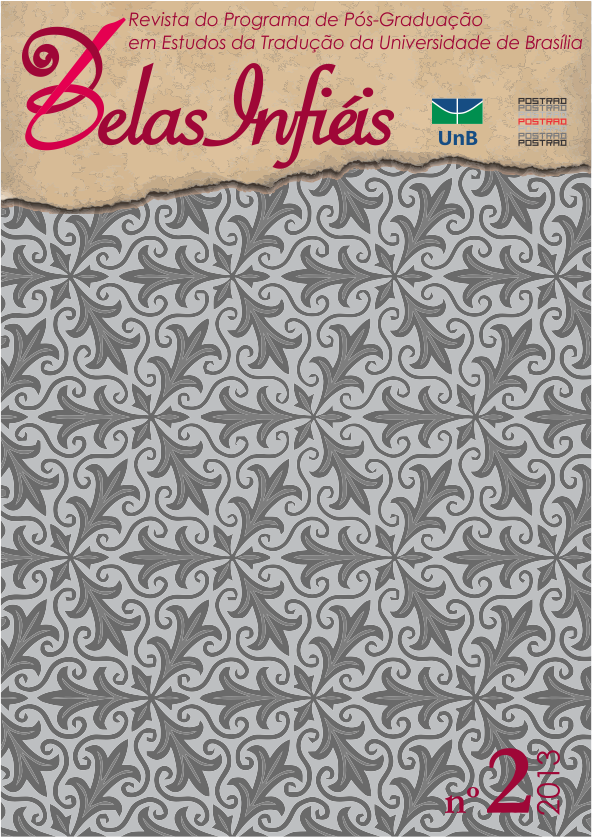O USO DO TRANSLOG© NAS PRIMEIRAS PRÁTICAS TRADUTÓRIAS
DOI :
https://doi.org/10.26512/belasinfieis.v2.n2.2013.11243Mots-clés :
processo tradutório, aprendizagem reflexiva, competência tradutóriaRésumé
Neste artigo relata-se a experiência do uso do Translog 2000© na disciplina de Prática de Tradução de Textos Gerais no Curso de Bacharelado em Tradução da UFPB. O objetivo das atividades desenvolvidas em sala de aula de semestres iniciais do Curso foi despertar o aprendiz de tradução para uma reflexão sobre a sua prática, além de familiarizá-lo com diferentes aspectos que envolvem e influenciam o desenvolvimento da atividade. Os protocolos de registro de teclado gerados pelo Translog foram analisados pelos próprios aprendizes como ponto de partida para a reflexão sobre a busca por soluções na tradução, sobre a duração das pausas durante o processo, sobre as escolhas tradutórias. A partir dessas reflexões, os aprendizes produziram um relatório final com suas observações. Pretendeu-se oferecer aos aprendizes uma aproximação real à prática, conscientizando-os a respeito de seu processo tradutório, de modo a buscar o desenvolvimento de sua competência tradutória.
Téléchargements
Références
ALVES, F. A formação de tradutores a partir de uma abordagem cognitiva: reflexões de um projeto de ensino. TradTerm, 4/2, 1997. p.19-40. Disponível em http://myrtus.uspnet.usp.br/tradterm/site/images/revistas/v04n2/v04n2a04.pdfAcesso em: 24 jan. 2013.
______. Tradução, cognição e contextualização: triangulando a interface processo-produto no desempenho de tradutores novatos. DELTA, v.19, n. esp.São Paulo,2003. Disponível em http://www.scielo.br/scielo.php?pid=S0102-44502003000300006&script=sci_arttextAcesso em: 24 jan. 2013.
ALVES, Fábio; MAGALHÃES, Célia; PAGANO, Adriana. Traduzir com autonomia: estratégias para o tradutor em formação. São Paulo: Contexto, 2003.
BRITTO,P. H. As condições de trabalho do tradutor. Cadernos de Tradução, v.1, n.19, 2007. p.193-204.Disponível em https://periodicos.ufsc.br/index.php/traducao/article/view/6998/6483Acesso em: 11 dez.2012.
HURTADO ALBIR, Amparo. Traducción y Traductología. Introducción a la traductología. 3.ed. Madri: Cátedra, 2007.
______. A aquisição da competência tradutória: aspectos teóricos e didáticos. In: PAGANO, Adriana; MAGALHÃES, Célia; ALVES, Fábio.Competência em Tradução: Cognição e Discurso. Belo Horizonte: Editora da UFMG, 2005. p.19-57.
LEIPNITZ, Luciane. Da descrição dos usos da língua aoensino da tradução: combinatórias textuais em língua alemã e implementação do ambienteVirtualern. Porto Alegre, 2010. Tese (Doutorado em Letras) ”“Programa de Pós-Graduação em Letras -Universidade Federal do Rio Grande do Sul.Disponível em http://www.ufrgs.br/termisul/biblioteca/teses/tese_PPG-Letras_2010_LEIPNITZ.pdfAcesso em: 24 jan.2013.
LIPARINI CAMPOS, T. A abordagem processual nos estudos da tradução. Anais do SILEL. Volume 2, Número 2. Uberlândia: EDUFU, 2011. Disponível em http://www.ileel.ufu.br/anaisdosilel/pt/arquivos/silel2011/1948.pdfAcesso em fevereiro de 2013.
______. O efeito do uso de um sistema de memória de tradução e da pressão de tempo no processo cognitivo de tradutores profissionais.Belo Horizonte, 2010. Tese (Doutorado em Linguística Aplicada) -Faculdade de Letras da Universidade Federal de Minas Gerais/PosLin.
PAGANO, A.; MAGALHÃES, C.; ALVES, F. Competência em tradução. Cognição e discurso. Belo Horizonte: UFMG, 2005.
ROBINSON, Douglas. Construindo o tradutor. Tradução de Jussara Simões. Bauru, SP: EDUSC, 2002.
SAID, F. M. Fidus Interpretes: A prática da tradução profissional. São Paulo: Edição do autor, 2010.
SNELL-HORNBY, Mary; HÖNIG, Hans G.; KUβMAUL, Paul; SCHMITT, Peter A. (Hrsg.). Handbuch Translation. 2.verbesserte Auflage. Tübingen: Stauffenburg Verlag, 2006.
Téléchargements
Publié-e
Comment citer
Numéro
Rubrique
Licence
Copyright Statement
Given the public access to this journal, the texts are free to use but requires the recognition of the original authorship and initial publication in this journal to be properly stated.
The journal allows the use of works published for non-commercial purposes, including the right to submit the work to publicly accessible databases. Published contributions are the sole and exclusive responsibility of the author(s).
- When submitting papers to be evaluated by the Belas Infiéis journal, the author(s):
- Declare that the contents of the contributions are original and of their original creation, being entirely responsible for their content if there is an objection by third parties.
- Claim to be aware that they should not commit academic plagiarism.
- Declare that the manuscript has not been published, completely or partially, in Portuguese or another language. If it is a translation it should be submitted to the Translated Articles section.
- Declare that the manuscript is not being evaluated by other journals.
- Declare that the manuscript was not submitted to another journal simultaneously.
- Commit(s) to inform the journal of any kind of error or inaccuracy in their contribution (published, in evaluation or in editing) and to collaborate with the editors to make due corrections of the article (when in evaluation or editing) or erratum/retraction (after publication).
- Declare that there is no conflict of interest regarding the published work.
- Authorize its release if it is accepted for publication without any kind of monetary compensation.
- Agree to assign non-exclusive rights to publication to the magazine, remaining free to make their contribution available in other media as long as the publication of the first version in Belas Infiéis magazine is mentioned. They also authorize Belas Infiéis to assign their texts for reproduction in content indexers, virtual libraries and similar platforms.
- Maintain copyright and grant the journal the right of first publication, the work being licensed under theCreative Commons Attribution License.
- Is/Are allowed and encouraged to publish and distribute their work online after the editorial process, which may increase the impact and citation of the published work.
- Authorize the editorial team to make textual adjustments and to adapt the article to the publication rules, when necessary.



















